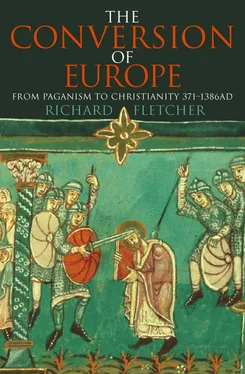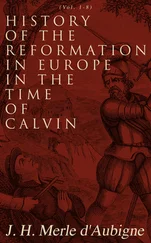Of course, we may again wonder – but did Jonas? – in what sense these Suevi had become Christians and what happened to their spiritual life after Columbanus had moved on to Bobbio in the following year. We do know that Columbanus’ disciple Gallus was left behind as a hermit beside Lake Constance and undertook evangelizing operations there. The site of his hermitage was to become one of the most celebrated of all medieval monasteries, taking its name from him – St Gallen.
We do not have to rely on his biographer to sense the apostolic impulse in Columbanus. It is attested in his own writings. In a letter written in 610 he spoke of ‘my vow to make my way to the heathen to preach the gospel to them’. Was Columbanus a monk or was he a missionary? The antithesis is misplaced. To be the kind of monk he was, in the age in which he lived, was also to be an evangelist.
*It should be borne in mind both here and in later chapters that clerical celibacy, though from a very early date regarded as praiseworthy, was not widely enforced within the western church before the twelfth century; and thereafter only with difficulty.
*It is tiresome that we have two near-contemporary saintly Irishmen with the same name, Columba, the Latin word for ‘dove’. The older of the two, Columba of Iona, is sometimes called Columba the Elder, sometimes by his Irish name Columcille, ‘Dove of the Church’. The younger is usually known by his Latin name in its masculine form, Columbanus, sometimes Englished as Columban. In this book I follow the convention of referring to the elder as Columba and to the younger as Columbanus.
CHAPTER FOUR
The New Constantines
My heart is white with joy; your words are great and good. It is enough for me to see your clothing, your arms and the rolling houses in which you travel, to understand how much intelligence and strength you have … I have been told that you can help us … You shall instruct us. We will do all you wish. The country is at your disposal.
Moshoeshoe, king of Lesotho, to Eugène Casalis, 1833
THE ENTRY OF the Tervingi into the empire in 376, the victory of Fritigern at Adrianople two years later, and the settlement of his people under treaty arrangements in Moesia four years after that proved to be but the opening scenes in the political drama which ended with the collapse of the Roman empire in the west and its replacement by a number of barbarian successor-states. It is as well to be clear about what this process was not before we go any further. The empire did not disappear in the fifth century. It is true that there was no emperor in the west after 476, but no one at the time could have guessed that this was more than a temporary hiatus. Authority reverted, at least in theory, to the emperor in Constantinople, where the Roman empire would survive for another millennium. But the western provinces did effectively come under new masters. They arrived by a variety of means. Whenever and wherever possible, the imperial government tried to control, or at least to influence and shape, the process of arrival. As we have seen, the descendants of Fritigern’s Tervingi were settled in Aquitaine in 418. We may now call them, as they had begun to call themselves, the Visigoths. In the course of the next half-century they were sometimes used as military federates in the name of the emperor of the day. For example, it was the Visigoths who bore the main brunt of the fighting at the battle of Châlons in 451, in which Attila and the Huns were defeated. Another contingent of Germanic troops at this decisive battle was furnished by the Burgundians. They too had been settled under treaty, with primary responsibility for defending the entry into Gaul by way of the upper valleys of the Rhône system against yet another Germanic people, the Alamans, who were pressing into the sensitive gap between Rhine and Danube in the Black Forest region. In the course of the fifth century the Burgundian kingdom expanded to include much of the Rhône valley and what is now western Switzerland. Another group of Goths, descendants of the Greuthingi who had been defeated by the Huns in the 370s, emerged in the northern Balkans out of the wreckage left by the collapse of the Hun empire in the 450s. They entered Italy under their leader Theoderic on behalf of the authorities in Constantinople to fight the empire’s enemies. The Ostrogothic kingdom of Italy established by Theoderic in 493 was notable for the harmonious co-existence within it of Goths and Romans.
The Burgundians, Ostrogoths and Visigoths constituted three successor-states in the western provinces of the empire which were founded to some degree in obedience to imperial political initiatives. Other peoples seized initiatives for themselves. In the winter of 406–7 the Rhine frontier collapsed and was penetrated by numbers of barbarian peoples, among them the Sueves and the Vandals. They made their way through Gaul, then in 409 moved south across the Pyrenees and made themselves masters of the provinces of Roman Spain. The Vandals crossed the Straits of Gibraltar in 429 and set up a kingdom for themselves, governed from Carthage, in what had been the imperial provinces of north Africa. Their place in Spain was subsequently taken by the Visigoths, while the Sueves were confined to a kingdom in the north-west quarter of the peninsula. All these peoples had lived in more or less close proximity to the empire’s frontiers before they crossed them. We may think of them as being in general not unlike the Gothic peoples among whom Ulfila worked in the fourth century, already touched to varying degrees by Roman culture. The process of acculturation to Romano-Mediterranean ways and values became for all of them more intense after entry into the empire.
What is specially relevant for us is that migration and settlement upon imperial soil were accompanied by conversion to Christianity. This had been a part of the agreement worked out between Fritigern and Valens before the crossing of the Danube in 376. Here is the fifth-century church historian Sozomen: ‘As if to return thanks to Valens, and as a guarantee that he would be a friend to him in all things, he [Fritigern] adopted the emperor’s religion and persuaded all the barbarians under his rule to adopt the same belief.’ 1 We should understand this conversion, it has been observed, not as ‘adherence body and soul to a new set of beliefs’ but rather as ‘a determination to change public practice’. 2 Official thinking appears to have been: we’ll take these people, but they must accept our empire’s faith. This was a pattern that repeated itself. Burgundians, Ostrogoths, Sueves and Vandals all accepted Christianity soon after their entry into the empire. It is a process that has to be inferred, because – remarkably enough – our sources do not mention it as such. Reasons for the reticence of the sources can be offered, some more convincing than others. However, modern scholars are agreed that the inference is a sound one. The other notable feature of the conversion of these barbarian peoples was that they all adopted the heretical, Arian form of Christianity as opposed to the orthodox or ‘Catholic’ credal formulations of Nicaea. (There were some temporary exceptions to this rule. One of the early Suevic kings in the middle years of the fifth century was a Catholic, but his successors were all Arians. The Burgundian rulers seem to have been Catholic in the middle years of the fifth century but went Arian towards its end.) The reasons for this Germanic preference for the creed of Arius remain elusive: we have simply to accept it as part of the overlapping pattern of religious allegiance in these years. On top of the world of rural pagans slowly being coaxed into some semblance of Christian belief and observance by activists like Martin of Tours, alongside the Catholic bishops in their cities, the Catholic suburban monasteries, the Catholic gentry and the Catholic middle class, we must now make mental room for an Arian clerical hierarchy, Arian kings and queens and warrior aristocrats, Arian churches with Arian liturgies being sung within them. This religious apartheid persisted in the kingdoms concerned until their governing circles decided to go over to Catholicism. This occurred in Burgundy during the reign of King Sigismund (516–23), in the Vandal kingdom when it was reconquered by Justinian’s armies and re-united to the empire in 533–4, in the Suevic kingdom in the 560s, and in the Visigothic kingdom in the years 587–9. The Ostrogothic realm had been destroyed in the course of Justinian’s attempts to reconquer Italy as he had reconquered Africa. Hardly were these long and costly campaigns over – they lasted almost without a break from 535 to 553 – than Italy was invaded by another group of migrating Germanic invaders, the Lombards, from 568 onwards. The religious affiliations of the Lombards are not easy to follow, but there was certainly an Arian presence in the Lombard kingdom until the middle years of the seventh century: the last Lombard king known to have been an Arian was Rothari (636–52).
Читать дальше












